
James Hoard
-
Posts
632 -
Joined
-
Last visited
-
Days Won
1
Content Type
Profiles
Forums
Blogs
Gallery
Events
Store
Posts posted by James Hoard
-
-
Is there any evidence of Arabic script anywhere on the reverse side of this decoration?
If,like the obverse, there is no Arabic inscription I would doubt very much if this was a Moroccan decoration. It may well have been conferred on Moroccan troups who took part in the campaign but, if so, probably conferred by the Congolese government.
Cheers,
James Hoards
0 -
Mangkoenegoro IV
wearing:
Order of Netherland Lion
???

He served as a young officer during the Java War of 1826-1830 with the Mankunegaran Legion's Parjurit Company and Captain of Infantry. So the second decoration was probably for those services. Was there a "War Cross" for that campaign?
Cheers,
James
0 -
Sultan Hamengkoe Boewono VIII with Governor Generalgeneral, so many decorations!! anyone can help identify them??
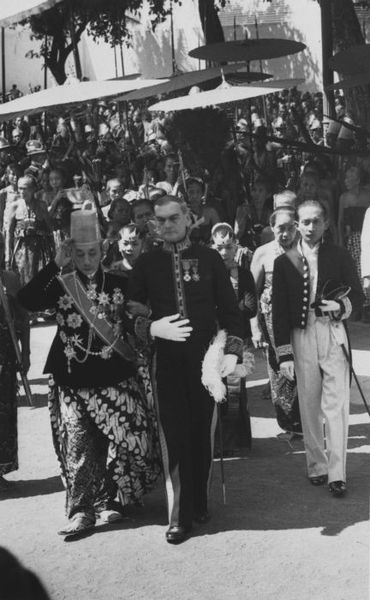
I don't think that is the Governor-General but probably the local Resident or Governor.
The Sultan's list of decorations read as follows: Knight Grand Cross of the Order ofOrange-Nassau, and Commander of the Order of the Netherlands Lion, Grand Cross of the Orders of the Wendish Crown of Mecklenburg,Royal Order of Cambodia, and Black Star of Benin of France, Grand Cordon (2nd class) of theOrder of the Brilliant Jade of China, Knight Commander of the Order of the Crownof Siam, Grand Cordon of the Order ofLeopold, Grand Officer of the Order of Leopold II of Belgium, and the Order ofthe Million Elephants and White Parasol of Luang Prabang, Commander with Star of theOrder of Vasa of Sweden.
Although some can be seen clearly in your picture, it is far too small to identify all of them very accurately.
Cheers,
James Hoard
0 -
SISKS Pakoe Boewono IX
Wearing:
Order of Kasenapaten
???
Order of Netherlands Lion
???
???

The other orders would be the Bintang Kumpeni, Bintang Dandaels and the Kanjeng Kyai Suryawasesa. Although the last is highest ranking of all the Surakarta decorations, I would not be able to point out which one is which.
Cheers
James Hoard
0 -
Unknown (Sultan Lingga?? or Sultan Siak?? or who??)
wearing:
Order of Oranje Nassau
and i'm not sure about the other order, any thoughts??
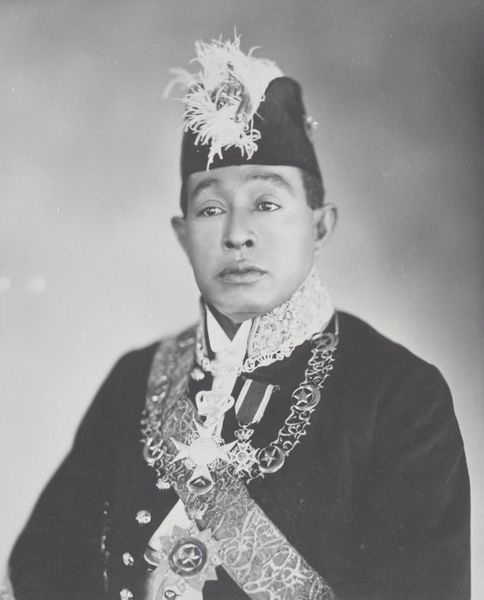
This is a portrait of H.H.Sri Paduka Sultan al-Sayyid Sharif Muhammad ibni al-Marhum Sultan al-Sayyid Sharif Yusuf al-Kadri, Sultan of Pontianak, reigned 1895-1944. He was beheaded by the Japanese, along with a score of other Bornean rulers at Mandor in June 1944.
Apart from the ON, the other orders are his own.
The picture seems to date from a period relatively early in the twentieth century. By the late 1930's the Sultan seems to have instituted at least two other orders. Alas, I have still not even been able to discover even their names, let alone any details about them. The present Sultan and his family do not know anything about these decorations.
Cheers,
James Hoard
0 -
I got some photos from my friend, he got it from Tropenmuseum, Netherland,
This photo were taken when Indonesia still called Nederland Indie (under Dutch)
Anyone can help identify the ODM of these poeple?
Here some of them:
Local ruler of Karangasem:
wearing:
1. Order of Oranje Nassau Officer
2. ???
3. Nichan al Iftikar - Tunisia
4. ???
5. Order of White Elephant-Thailand

This picture is of H.H. Sri Paduka Ratu Anak Agung Agung AnglurahKetut Karangasem, Raja of Karangasem, reigned 1908-1950.
The orders and decorations that he held were: Officer of the Order of Orange-Nassau, Great Gold Star for Loyalty and Merit, Nishan-i-Iftihkar 4thclass of Tunisia, Officer of the Order of the Black Star of Benin of France,and 5th class of the Order of the White Elephant of Siam. All of which you can see worn in the picture.
Cheers
James Hoard
0 -
Hi Brian,
Certainly an interesting question that I've asked myself before.
First, I'd start with the cultural factors that I believe Rich has already pointed on the other thread that got this one going. Simply few occasions for actually wearing them! Meaning - few occasions to actually handle them. Less human contact automatically lends itself to a better state of preservation considering that we, biologically-speaking, are fairly detrimental to the well-being of many materials.
Second, I might look at the numbers of awards made - some of these are into the millions - the Russo-Japan War medal, the China Incident Medal - to name a few - hence, it isn't too hard to find these in really nice condition. Same thing with some of the orders - many of these were made, and it is not hard to find post-war examples that simply aren't that old relatively speaking so it's not unusual that you'd find really nice specimens. There is an observable proportionality though of what is nice to how old it is - this would be expected - as you go back further in time, you find fewer and fewer nice examples of awards. Look at the Sino-Japanese war or Boxer Rebellion medals, not made in near the same numbers as say the Russo-Japan war medals, so no way you find them as nice - plus, I am also under the belief that there was a change in dyes being used in the early 1900s that were more fast than earlier dyes - a theory based on the number of Sinos and Boxers that you see suffering from color bleed. Though I'm probably just stabbing at things in the dark with my crackpot theories......

Third, gotta look at the very materials that were used - lacquer ware is very durable, especially if it goes largely untouched, and stored well. Let's face it, these aren't things seeing daily use and handling so nice cases should be expected. Paulownia wood too is fairly bug resistant, though you do find these wooden cases with the occasional worm hole. Still, the wood is actually light but tough and resilient. I'd also imagine that many of these were packed in cedar chests or some other kind of storage that would have a preservative effect.
From what I gather, there are few fakes on the market. I think the quality of Japanese awards would be hard to replicate short of a significant investment - and this would only be worth it for higher class awards, not common items. There a lot of elements that one would have to duplicate correctly - It's not worth the effort and time for a medal that you can buy for a relatively low sum. That said, I'd be wary of buying anything out of China period. These are simply my opinions though.
You do find a lot of medal groups on Yahoo! Japan, far fewer on eBay, this is true. How authentic the groups are is harder to tell - are they genuine, or simply cobbled together by a seller to make a few more bucks? I'd like to think that there was still some honor in Japan and that most items are legitimate, but there are those unfortunate few that put money above that honor. Still, I believe them to be a minority.
I know none of these things are answers to the questions, merely thoughts! I am very interested to see how this thread develops!
I would also add under "cultural factors" the very particular attitude of the Japanese to these things. First, the awards come from the Emperor and are a gift from him. So they have a sacredness of sorts attached to them. Second, the Japanese are very careful with such things anyway. In the normal antique and art markets, unless things are in perfect condition, they simply do not buy!
Cheers,
James
0 -
Of all the colonies which the British left post WWII, only two - the first one, Burma, & one of the last, Aden, were to reject membership of the Commonwealth.
A wonderful post and wonderful thread to read through and enjoy, but I am not at all sure of the accuracy of the above statement.
What about Sudan, Somaliland, Egypt, Jordan, Iraq, Palestine/Israel, Nepal, and all the Gulf states. Not to mention Pakistan going out and coming in several times.
Cheers,
James.
0 -
I agree that he deserved this medal!
Without question.
I had noticed that some of the gainsayers who appeared here to join comment have been careful with their words. Not so when the same individuals have commented on Beharry's VC in other fora, where the comments had more than a tinge of that very debilitating illness - racism.
Cheers,
James Hoard
0 -
So around his neck he has the KCB & KCVO, on his chest he's wearing the Order of the Garter (right) and the GCB (bottom) - but what's the one on the left? And where's the GCMG? And what's the medal (w/red ribbon) in the 7th position, where the Italian Military Order of Savoy would've gone?
Harvey,
The neck badge is the Sovereign's badge of the Order of the Bath (not the KCB).
The chain is the Royal Victorian Chain (not the KCVO)
As I said, he is kitted out for the French State Visit so the breast star of the Legion of Honour is given equivalent place beside the Garter. The riband is also the Legion of Honour.
The removal of the Military Order of Savoy means that the Russian Order of St Vladimir 'with sword's moves up a place.
Cheers,
James
0 -
Here is a print-out of a photograph of the actual uniform and decorations worn by George VI, dressed-up for the French State Visit, from the Royal Collection at
http://www.royalcoll...&detail=magnify
Note the sovering's badge of the Order of the Bath with St Edward's Crown, the Queen Victoria Diamond Jubilee Medal in silver with clasp, crowned Edward VII Cornation Medal, and the absence of the Military Order of Savoy (in accordance with the ruling on Italian decorations in 1941).
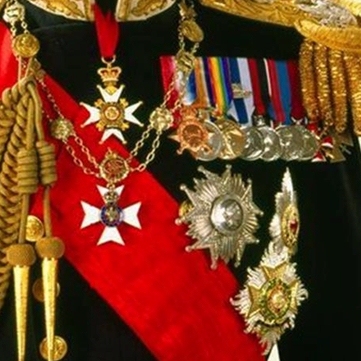
Cheers
James
0 -
The Edward VII Coronation Medal is the 5th from the left I think, but you are right that the riband should go under the belt. Something I did not notice.
That seems to have the appropriate Edward VII Coronation ribbon, but the medal itself is something else. As far as I know, the actual EVII Coronation Medal has a raised wreath around the edge and a crown between the top of the rim and the ribbon suspension loop.
Cheers,
James
0 -
The only two I see right off the bat are that he's missing the Mention In Dispatches palm on his WWI Victory Medal and the palm on his Croix de Guerre. And wouldn't the rosettes on his Italian & Russian medals be bigger?
Indeed so.
The Edward VII Coron Medal is missing and the Garter riband goes under, not over the belt.
I take back what I said about creative skills. They have been allowed to go beserk with whatever is in place third from right, where the Military Order of Savoy is supposed to be. Looks like someone has started off with a Spanish Isabel the Catholic and made "creative adjustments".
As for the first photograph, I still do not see any evidence of the GCIE. There is a slight shadow cast by the ribbon of the GCVO ribbon, just like the GCB above it, nothing more.
Cheers,
James
0 -
I have no idea, but I would like to know if they are correct.
The costumiers invariably get these things wrong. In this case he or she has assumed that there is nothing under the lapel. Consequently, the GCIE is missing.
I suppose one good thing this time is that he has stopped himself from exercising his 'creative skills' and invented something completely different.
Cheers,
James
1 -
This is a terrific thread. I hope we'll see more, including the regulations if you ever get them, Windu. .
How many rulers in the islands issued their own ODM?
Hugh,
There is little or no information available either from local or Dutch medal collectors and even from the palaces themselves.
Since I collect photographs of rulers, I do see local decorations featuring in them from time to time. From these portraits of the 1930's and 1940's, I know that the following Indonesian rulers had their own orders and decorations:
- Surakarta (Java)
- Pontianak (Kalimantan)
- Sambas (Kalimantan)
- Langkat (Sumatra)
- Siak (Sumatra)
Yogyakarta (Java) has decorations but I gather that they are only for the Sultan himself and not distributed to other members of his family or subjects. They are called 'pusaka', which means heirloom, and thus form part of the Sultan's official regalia.
Cheers,
James
0 -
this is the 5th class set:
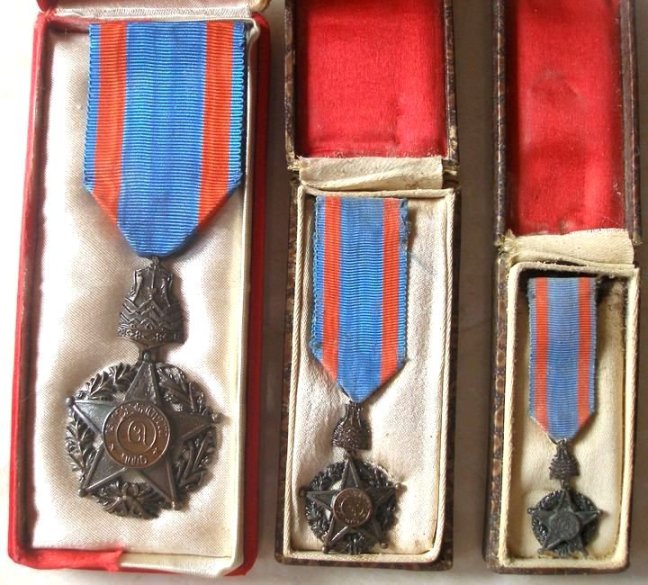
Windu,
Many thanks for posting the image of the 5th class. It helps a lot to see the ribbon in full colour.
It is also interesting to see the two types of miniature.
Cheers,
James
0 -
oh, and please be careful when you buy surakarta odm, many of them bad repair, or bad repaint..
And sometime the seller expect too much from foreigner (i ever see a poor condition east dutch indies copper medal priced more than $5000, and i'm sure that the fair value is not more than $40!)
And till now there many unclear information about the odm..
asking the expert like James will be better before you decide to buy..

Dear Windu
Thanks for both your posts.
Your descriptions of the ribbons may suggest that each class had a different arrangement of colours. Are the lower class ribbons in your pictures exactly the same for both in terms of arrangement of the colours, width of stripes, location of stripes, etc or slightly different?
Could you please tell us what is the Javanese term for loyalty, and thus the full official name for the order in Javanese?
I am by no means an expert. There is very little information on these orders in Western sources, so I am learning all the time. You are, however, quite right about values and quality as can be seen from inverted decoration I posted much earlier. The restoration looked like it was merely painted rather than enamelled.
Cheers,
James
0 -
order of loyalty 3rd class Kraton Kasunanan Surakarta with original case, from SISKS Paku Buwono X
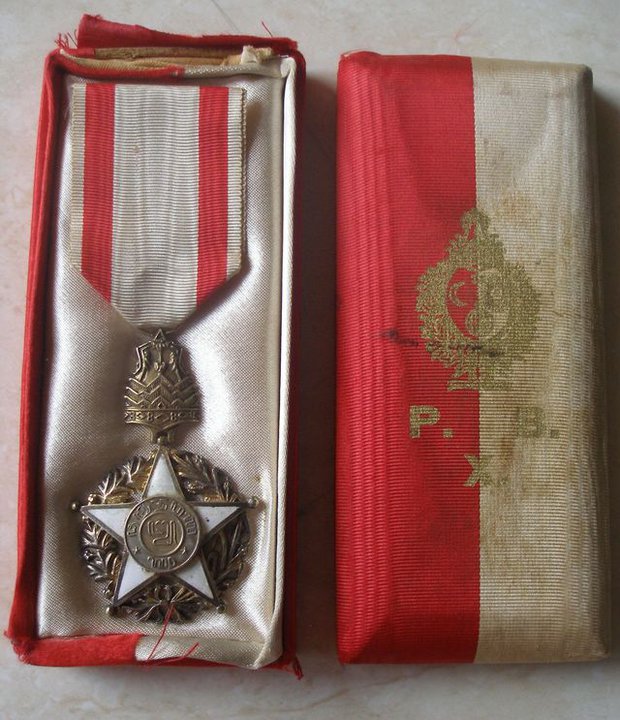
Windu,
Many thanks for posting this rare decoration.
Is the ribbon correct or is it a new replacement with the ribbon for the Bintang Kraton decoration?
I ask because I have this photograph of Prince Soejono Handayaningrat from the 1950's wearing a higher class of the same decoration, but the ribbon is dark with either white (or a light colour) edge stripes. Here is a blow up of the two decorations he is wearing.

Cheers,
James
0 -
Persia Homayoun Lion and Sun Grand Cross
Pahlavi period 1925-41
A new system of official honors was instituted by the Pahlavi dynasty. The Lion and Sun decoration was continued, with major modifications, from the Qajar period. The five classes of the Lion and sun for civilians persisted under the name Homayoun. The Homayoun was a simplified and modernized version of the original Qajar Lion and sun. The badge consisted of a central medallion bearing an enameled disk of the lion with upraised sword andthe rising sun, framed within a six-pointed star; the star was a similar badgesuperimposed upon a sunburst with eight points; the third class consisted only of the star, without the badge. The first class was worn with a green sash bordered in red stripes, the second class suspended from a red-bordered green ribbon by means of a rosette. There was also a Homayoun medal, with three grades, of gold, silver, and bronze, intended for lower-ranking civil servants. In the last decades of the Pahlavi dynasty it ceased to be awarded. The breast badges with the eight enameled green rays were the first type issued and later breast badges had no enameled rays. The manufacture of this posted breast cross medal was the French firm Arthus Bertrand.
Any additional information and photos pertaining to this order would be greatly appreciated.
Thanks, Marcus
Marcus,
Thanks for posting this lovely image.
The Order of Humayoun (which means' the August') was an entirely new order and had nothing to do with the earlier Qajar Order of the Lion and Sun.
Although the image of the Lion and Sun was used for the new order, this is a national symbol and used in many instances. On the contrary, that Order of the Lion and Sun had become so discredited and so associated with corruption that everybody, the Pahlavis and even the last Qajar Shah wanted to drop any association with it. Indeed, if one looks at the Humayun, the only link is in the use of the Iranian national symbol, though even then the illustration is very different. The ribbon, shape of the badges and stars, classes, method of wear, are all different.
For comparative purposes if one looks at the British system of honours, the use of the St George symbol (and even name) for the George Cross, George Medal or the Order of St Michael and St George does not mean that all of these are part of the Order of the Garter!
Cheers,
James Hoard
0 -
Well, here's one I didn't see coming. The British Order of Merit has been reinstated in the Canadian Honours System.
Anybody know when this happened? I has to be recent, I just only found out by going on the DHH web site for some other info.
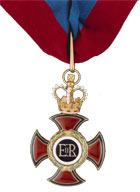
My understanding was that all the non-political decorations that are conferred by HM on her own initiative, as opposed to "on the advice of her ministers", provided that they are non-titular,have remained part of the Canadian Honours System throughout.
In effect this means the Royal Victorian Chain, Order of Merit, the Royal Victorian Order in the ranks of Commander, Lieutenant and Member, and the Royal Victorian Medal.
Appointments are listed in both the London Gazette and Canada Gazette. There are usually a few appointments to the Royal Victorian Order every year.
Pretty much the same applies in Australia, New Zealand and Jamaica. Though in these cases HM is entitled to confer the titular decorations also, i.e. the Garter, Thistle, GCVO and KCVO.
Cheers,
James Hoard
0 -
Hi guys.
I'm off to KL in Malaysia this year for a little holiday.
With the fiancee stretching up for some serious shopping, I thought I would try and hunt down some Malaysian ODM.
I was hoping if anyone could give advice regarding on where to look or if I should be weary of any laws regarding trying to bring a medal home.
I am really hoping to try and get my hands on a Order of the Crown of Jahore. Will I have any chance?
Any help on locations and maybe even some ball park prices would be greatly appreciated!!!!
Johore orders will be pretty hard to come by as they have always been awarded rather sparingly, unlike the other Malaysian states. Sometimes a year can go by without a single award appearing in the honours list. The medals will be easier to get. Either way, Singapore is probably going to be a more likely source than KL. Singapore is closer to JB and the Royal Family, court and officials tend to own property and frequent the place more than KL.
There used to be the Royal Medal Manufacturing Co (Singapore) somewhere near the golf course, but I looked them up on the net recently and they now seem to be into furniture! So it may be best to visit a few coin dealers in Singapore and ask around when there.
Cheers
James Hoard
0 -
Hello Emmanuel,
The original image was from a dealer (in Australia?) to a friend of mine. But the decoration seemed that it had been heavily and not wery well repaired, the "enamalling" looked like paint, so he did not go ahead with the purchase.
The ribbon is also a modern ribbon, as handed out by the Susuhanan of Surakarta from the 1980s/1990s.
Cheers,
James
0 -
Well then - it is an Honorary Award. Not being given for Service but, as an allocation ?
Not so. According to the official terminology of the statutes of orders concerned, as opposed to one invented-on-the-hoof, an honorary award is one that is supernumery to establishment. The Indian princes were part of the establishment.
0 -
Mike - a very interesting story - an Honorary award but, as you say - the last time one will be seen being worn. I think the expression which sums it up is - 'The Old Order Passeth !" As we all get older we are continually seeing the 'last' of things - I wonder what our present younger generations will remember in 50 years time ?
Certainly not honorary. The statutes of both Indian orders reserved a certain number of knighthoods in each to the Indian princes.
Also, in relation to a previous poster, although this particular prince was the last knight, he is certianly not the last prince to have ruled his own state. Furthermore, 1947 is an assumed but almost always an incorrect date. Incorporation in either India or Pakistan and the loss of sovereighnty varied according to princely state, and ranged anywhere from 1948 to as late as 1956.
0


Some Photos from Tropenmuseum
in South East & East Asia
Posted
Although I have seen that mentioned on the web, that decoration wasn't conferred on the Sultan of Jambi but on an envoy who went to Turkey. I had a note of his name somewhere but cannot now find it.
If you look carefully, the example is of a lower class decoration (3rd class?). A reigning Sultan would have at least received the 1st class or the murassa (bejewelled) grade.
Cheers,
James